Polarimetric SAR Time-Series for Identification of Winter Land Use
Abstract
1. Introduction
2. Materials and Methods
2.1. Study Site
2.2. Field Data
- Winter crops, which cover ca. 40% of the UAA (utilized agricultural area) and include three main annual crops: winter wheat, winter barley and rapeseed
- Grasslands, which cover ca. 30% of the UAA and can be mown or grazed
- Catch crops, which are sown after harvest of the main crop from August to October, cover ca. 25% of the UAA and include a wide variety of crops
- Crop residues, which cover ca. 5% of the UAA and correspond to maize stalks that are left in fields when the maize is harvested after 1 November [3]
2.3. Satellite Data
2.3.1. RADARSAT-2 Time-Series
2.3.2. Sentinel-1 Time-Series
2.3.3. ALOS-2 Time-Series
2.4. Extraction of SAR Parameters
2.4.1. Quad-Pol Time-Series
- Backscattering coefficients (, , , ) were calculated from the radiometrically calibrated RST-2 time-series using SNAP according to Equation (1) [34]:where β is the radar brightness and is the incidence angle at the range pixel.Equation (1) assumes that the Earth is a smooth ellipsoid at sea level. A Lee Sigma filter [35] was applied with a window of 7 × 7 pixels and a sigma value of 0.8. RST-2 images were then geocoded at an 8-m resolution using Shuttle Radar Topography Mission 3s data to correct topographic deformations. The accuracy of geometric correction was less than 8 m per pixel. Next, two backscattering ratios were calculated (σ°HH:σ°VV, σ°HH:σ°HV) that highlight scattering mechanisms of each target.
- Polarimetric parameters were calculated from SLC RST-2 time-series. First, a 3 × 3 coherency matrix was extracted from the scattering matrix () of each image using PolSARpro. Next, a Lee Sigma filter was applied with a window of 7 × 7 pixels and a sigma value of 0.8. The elements of the matrix, which are independent of the polarimetric absolute phase [36], were then geocoded directly using SNAP with an 8-m resolution.
2.4.2. Dual-Pol Time-Series
- Converting the RST-2 time-series polarization mode: Each 3 × 3 coherency matrix extracted from RST-2 quad-polarization images was converted to a 2 × 2 covariance matrix using PolSARpro. The converted RST-2 images had the same polarizations (HH and HV) as ALS-2 images.
- Calculating S-1 and ALS-2 covariance matrices: A 2 × 2 covariance matrix () was extracted from the two polarizations of each ALS-2 2-m image and each S-1 image (for S-1 dense and sparse time-series).
- Resampling RST-2 and ALS-2 time-series: A multi-looking function was applied using a 2 × 1 pixel window for RST-2 images (i.e., 2 × 4.7 m and 1 × 8.2 m) and a 5 × 6 pixel window for ALS-2 images (i.e., 5 × 1.9 m and 6 × 1.4 m) using PolSARpro. Resampled RST-2 images had a resolution of 9.4 × 8.2 m, which was close to that of resampled ALS-2 images (9.5 × 8.4 m) and 10-m corrected S-1 images.
- Calibrating backscattering coefficients: Backscattering coefficients σ°HH and σ°HV were simultaneously calibrated radiometrically from dual-pol converted and resampled RST-2 images and original and resampled ALS-2 images using SNAP. Backscattering coefficients σ°VV and σ°VH were simultaneously calibrated radiometrically from dual-pol S-1 images. Then, a Lee Sigma filter [35] with a window of 7 × 7 pixels and a sigma value of 0.8 was applied to all images to attenuate speckle noise. Next, geometric correction was performed using the Shuttle radar topographic mission (SRTM) for each time-series dataset, with a 2-m resolution for original ALS-2 images; 8-m resolution for original RST-2 images and 10-m resolution for resampled ALS-2, resampled RST-2 and the two S-1 images. Finally, the ratio and σ°HV difference were calculated from ALS-2 and RST-2 backscattering coefficients, and the ratio and σ°VV difference were calculated from S-1 backscattering coefficients.
- Extracting polarimetric parameters: Dual-polarimetric parameters were simultaneously extracted from dual-pol S-1 images, converted and resampled RST-2 images and original and resampled ALS-2 images. To this end, the same Lee Sigma filter was applied to the matrices to filter out speckle noise. Then, geometric corrections were applied to all polarimetric parameters using the SRTM with the previously used 2-m, 8-m and 10-m resolutions. SPAN, SE, SEi, SEp, normalized SE, normalized SEi and normalized SEp were also extracted.
- original RST-2 8-m dataset with 110 variables (11 parameters × 10 dates)
- resampled RST-2 10-m dataset with 110 variables (11 parameters × 10 dates)
- original ALS-2 2-m dataset with 66 variables (11 parameters × 6 dates)
- resampled ALS-2 10-m dataset with 66 variables (11 parameters × 6 dates)
- sparse S-1 10-m dataset with 88 variables (11 parameters × 8 dates)
- dense S-1 10-m dataset with 220 variables (11 parameters × 20 dates)
2.5. Classification of SAR Parameter Datasets
- RST-2 quad-pol, S-1 dense and ALS-2 2-m time-series datasets were classified to demonstrate the full potential of these SAR sensors
- RST-2 10-m dual-pol, ALS-2 10-m and S-1 sparse time-series datasets were classified to identify the best band frequency
- RST-2 quad-pol and RST-2 8-m dual-pol time-series datasets were classified to identify the best polarization mode
- S-1 dense and sparse time-series datasets were classified to evaluate the influence of the number of images
3. Results
3.1. Importance of SAR Parameters for Discriminating Winter Land-Use
3.2. Contribution of Polarization Mode to Accuracy of Winter Land-Use Classification
3.3. Contribution of Band Frequency to Accuracy of Winter Land-Use Classification
3.4. Contribution of Time-Series Density to Accuracy of Winter Land-Use Classification
3.5. Definition of the Best SAR Configuration
3.6. Spatial Distribution of Winter Land-Use Classes
4. Discussion
4.1. Which SAR Configuration for Mapping Winter Land-Use?
4.2. Advantages and Disadvantages of the Classification Approach
5. Conclusions
Author Contributions
Funding
Acknowledgments
Conflicts of Interest
References
- Fasona, M.J.; Omojola, A.S. Climate change, human security and communal clashes in Nigeria. In Proceedings of the International Workshop on Human Security and Climate Change, Oslo, Norway, 21–23 June 2005; pp. 21–23. [Google Scholar]
- Corgne, S. Hiérarchisation des facteurs structurant les dynamiques pluriannuelles des sols nus hivernaux. Application au bassin versant du Yar (Bretagne). Norois Environ. Aménage. Société 2004, 193, 17–29. [Google Scholar] [CrossRef]
- Denize, J.; Hubert-Moy, L.; Betbeder, J.; Corgne, S.; Baudry, J.; Pottier, E. Evaluation of using sentinel-1 and-2 time-series to identify winter land use in agricultural landscapes. Remote Sens. 2019, 11, 37. [Google Scholar] [CrossRef]
- Duchemin, B.; Fieuzal, R.; Rivera, M.A.; Ezzahar, J.; Jarlan, L.; Rodriguez, J.C.; Hagolle, O.; Watts, C. Impact of sowing date on yield and water use efficiency of wheat analyzed through spatial modeling and FORMOSAT-2 images. Remote Sens. 2015, 7, 5951–5979. [Google Scholar] [CrossRef]
- Veloso, A.; Mermoz, S.; Bouvet, A.; Le Toan, T.; Planells, M.; Dejoux, J.-F.; Ceschia, E. Understanding the temporal behavior of crops using Sentinel-1 and Sentinel-2-like data for agricultural applications. Remote Sens. Environ. 2017, 199, 415–426. [Google Scholar] [CrossRef]
- Morena, L.C.; James, K.V.; Beck, J. An introduction to the RADARSAT-2 mission. Can. J. Remote Sens. 2004, 30, 221–234. [Google Scholar] [CrossRef]
- Potin, P.; Bargellini, P.; Laur, H.; Rosich, B.; Schmuck, S. Sentinel-1 mission operations concept. In Proceedings of the 2012 IEEE International Geoscience and Remote Sensing Symposium, Munich, Germany, 22–27 July 2012; pp. 1745–1748. [Google Scholar]
- Drusch, M.; Del Bello, U.; Carlier, S.; Colin, O.; Fernandez, V.; Gascon, F.; Hoersch, B.; Isola, C.; Laberinti, P.; Martimort, P. Sentinel-2: ESA’s optical high-resolution mission for GMES operational services. Remote Sens. Environ. 2012, 120, 25–36. [Google Scholar] [CrossRef]
- Huang, H.; Chen, Y.; Clinton, N.; Wang, J.; Wang, X.; Liu, C.; Gong, P.; Yang, J.; Bai, Y.; Zheng, Y. Mapping major land cover dynamics in Beijing using all Landsat images in Google Earth Engine. Remote Sens. Environ. 2017, 202, 166–176. [Google Scholar] [CrossRef]
- Smith, L.C. Satellite remote sensing of river inundation area, stage, and discharge: a review. Hydrol. Process. 1997, 11, 1427–1439. [Google Scholar] [CrossRef]
- Ulaby, F.T.; Moore, R.K.; Fung, A.K. Microwave Remote Sensing Active and Passive-Volume III: From Theory to Applications. 1986. Available online: https://ntrs.nasa.gov/search.jsp?R=19860041708 (accessed on 1 January 1986).
- Hosseini, M.; McNairn, H.; Merzouki, A.; Pacheco, A. Estimation of Leaf Area Index (LAI) in corn and soybeans using multi-polarization C-and L-band radar data. Remote Sens. Environ. 2015, 170, 77–89. [Google Scholar] [CrossRef]
- McNairn, H.; Brisco, B. The application of C-band polarimetric SAR for agriculture: a review. Can. J. Remote Sens. 2004, 30, 525–542. [Google Scholar] [CrossRef]
- Mascolo, L. Polarimetric SAR for the Monitoring of Agricultural Crops. Ph.D. Thesis, Universita’degli Studi di Cagliari, Cagliari, Italy, 2015. [Google Scholar]
- Hütt, C.; Koppe, W.; Miao, Y.; Bareth, G. Best accuracy land use/land cover (LULC) classification to derive crop types using multitemporal, multisensor, and multi-polarization SAR satellite images. Remote Sens. 2016, 8, 684. [Google Scholar] [CrossRef]
- Haldar, D.; Rana, P.; Yadav, M.; Hooda, R.S.; Chakraborty, M. Time series analysis of co-polarization phase difference (PPD) for winter field crops using polarimetric C-band SAR data. Int. J. Remote Sens. 2016, 37, 3753–3770. [Google Scholar] [CrossRef]
- Skriver, H. Crop classification by multitemporal C-and L-band single-and dual-polarization and fully polarimetric SAR. IEEE Trans. Geosci. Remote Sens. 2012, 50, 2138–2149. [Google Scholar] [CrossRef]
- Skriver, H.; Svendsen, M.T.; Thomsen, A.G. Multitemporal C-and L-band polarimetric signatures of crops. IEEE Trans. Geosci. Remote Sens. 1999, 37, 2413–2429. [Google Scholar] [CrossRef]
- McNairn, H.; Duguay, C.; Boisvert, J.; Huffman, E.; Brisco, B. Defining the sensitivity of multi-frequency and multi-polarized radar backscatter to post-harvest crop residue. Can. J. Remote Sens. 2001, 27, 247–263. [Google Scholar] [CrossRef]
- Jiao, X.; McNairn, H.; Shang, J.; Liu, J. The sensitivity of multi-frequency (X, C and L-band) radar backscatter signatures to bio-physical variables (LAI) over corn and soybean fields. In Proceedings of the ISPRS TC VII Symposium—100 Years ISPRS, Vienna, Austria, 5–7 July 2010; pp. 317–325. [Google Scholar]
- Nurtyawan, R.; Saepuloh, A.; Budiharto, A.; Wikantika, K. Modeling Surface Roughness to Estimate Surface Moisture Using Radarsat-2 Quad Polarimetric SAR Data. In Proceedings of the Journal of Physics: Conference Series, Bandung, Indonesia, 19–20 August 2016; Volume 739, p. 012105. [Google Scholar]
- Smith, A.M.; Major, D.J. Radar backscatter and crop residues. Can. J. Remote Sens. 1996, 22, 243–247. [Google Scholar] [CrossRef]
- Paris, J.F. Radar backscattering properties of corn and soybeans at frequencies of 1.6, 4.75, and 13.3 Ghz. IEEE Trans. Geosci. Remote Sens. 1983, 3, 392–400. [Google Scholar] [CrossRef]
- Lee, J.-S.; Grunes, M.R.; Pottier, E. Quantitative comparison of classification capability: Fully polarimetric versus dual and single-polarization SAR. IEEE Trans. Geosci. Remote Sens. 2001, 39, 2343–2351. [Google Scholar]
- Abdikan, S.; Sanli, F.B.; Ustuner, M.; Calò, F. Land cover mapping using sentinel-1 SAR data. Int. Arch. Photogramm. Remote Sens. Spat. Inf. Sci. 2016, 41, 757. [Google Scholar] [CrossRef]
- Dimov, D.; Löw, F.; Ibrakhimov, M.; Stulina, G.; Conrad, C. SAR and optical time series for crop classification. In Proceedings of the 2017 IEEE International Geoscience and Remote Sensing Symposium (IGARSS), Fort Worth, TX, USA, 23–28 July 2017; pp. 811–814. [Google Scholar]
- Bargiel, D. A new method for crop classification combining time series of radar images and crop phenology information. Remote Sens. Environ. 2017, 198, 369–383. [Google Scholar] [CrossRef]
- Minh, D.H.T.; Ienco, D.; Gaetano, R.; Lalande, N.; Ndikumana, E.; Osman, F.; Maurel, P. Deep recurrent neural networks for winter vegetation quality mapping via multitemporal SAR Sentinel-1. IEEE Geosci. Remote Sens. Lett. 2018, 15, 464–468. [Google Scholar] [CrossRef]
- ZA Armorique. Available online: https://osur.univ-rennes1.fr/za-armorique/ (accessed on 24 May 2019).
- Nitrates—Water Pollution—Environment—European Commission. Available online: http://ec.europa.eu/environment/water/water-nitrates/index_en.html (accessed on 24 May 2019).
- Open Access Hub. Available online: https://scihub.copernicus.eu/ (accessed on 10 September 2019).
- Kalideos. Available online: https://www.kalideos.fr/drupal/fr (accessed on 24 May 2019).
- Pottier, E.; Ferro-Famil, L.; Fitrzyk, M.; Desnos, Y.-L. PolSARpro-BIO: The new Scientific Toolbox for ESA & third party fully Polarimetric SAR Missions. In Proceedings of the 12th European Conference on Synthetic Aperture Radar, EUSAR 2018, Aachen, Germany, 4–7 June 2018; pp. 1–4. [Google Scholar]
- Radarsat 1 Products Image Resolution Geomatics. Available online: https://www.scribd.com/document/73559622/Radarsat-1-Products (accessed on 20 November 2017).
- Lee, J.-S.; Wen, J.-H.; Ainsworth, T.L.; Chen, K.-S.; Chen, A.J. Improved sigma filter for speckle filtering of SAR imagery. IEEE Trans. Geosci. Remote Sens. 2009, 47, 202–213. [Google Scholar]
- Lee, J.-S.; Pottier, E. Polarimetric Radar Imaging: From Basics to Applications; CRC Press: Boca Raton, FL, USA, 2009. [Google Scholar]
- Cloude, S.R.; Pottier, E. A review of target decomposition theorems in radar polarimetry. IEEE Trans. Geosci. Remote Sens. 1996, 34, 498–518. [Google Scholar] [CrossRef]
- Freeman, A.; Durden, S.L. A three-component scattering model for polarimetric SAR data. IEEE Trans. Geosci. Remote Sens. 1998, 36, 963–973. [Google Scholar] [CrossRef]
- Kim, Y.; Jackson, T.; Bindlish, R.; Lee, H.; Hong, S. Radar vegetation index for estimating the vegetation water content of rice and soybean. IEEE Geosci. Remote Sens. Lett. 2012, 9, 564–568. [Google Scholar]
- McNairn, H.; Hochheim, K.; Rabe, N. Applying polarimetric radar imagery for mapping the productivity of wheat crops. Can. J. Remote Sens. 2004, 30, 517–524. [Google Scholar] [CrossRef]
- Kostelich, E.J.; Schreiber, T. Noise reduction in chaotic time-series data: A survey of common methods. Phys. Rev. E 1993, 48, 1752. [Google Scholar] [CrossRef]
- Breiman, L. Random Forests. Mach. Learn. 2001, 45, 5–32. [Google Scholar] [CrossRef]
- Pal, M. Random forest classifier for remote sensing classification. Int. J. Remote Sens. 2005, 26, 217–222. [Google Scholar] [CrossRef]
- Belgiu, M.; Csillik, O. Sentinel-2 cropland mapping using pixel-based and object-based time-weighted dynamic time warping analysis. Remote Sens. Environ. 2018, 204, 509–523. [Google Scholar] [CrossRef]
- Liaw, A.; Wiener, M. Classification and regression by randomForest. R News 2002, 2, 18–22. [Google Scholar]
- R: The R Project for Statistical Computing. Available online: https://www.r-project.org/ (accessed on 10 September 2019).
- Lawrence, R.L.; Wood, S.D.; Sheley, R.L. Mapping invasive plants using hyperspectral imagery and Breiman Cutler classifications (RandomForest). Remote Sens. Environ. 2006, 100, 356–362. [Google Scholar] [CrossRef]
- Belgiu, M.; Drăguţ, L. Random forest in remote sensing: A review of applications and future directions. ISPRS J. Photogramm. Remote Sens. 2016, 114, 24–31. [Google Scholar] [CrossRef]
- Audebert, N.; Le Saux, B.; Lefèvre, S. Beyond RGB: Very high resolution urban remote sensing with multimodal deep networks. ISPRS J. Photogramm. Remote Sens. 2018, 140, 20–32. [Google Scholar] [CrossRef]
- Congalton, R.G. A review of assessing the accuracy of classifications of remotely sensed data. Remote Sens. Environ. 1991, 37, 35–46. [Google Scholar] [CrossRef]
- Jiao, X.; Kovacs, J.M.; Shang, J.; McNairn, H.; Walters, D.; Ma, B.; Geng, X. Object-oriented crop mapping and monitoring using multi-temporal polarimetric RADARSAT-2 data. ISPRS J. Photogramm. Remote Sens. 2014, 96, 38–46. [Google Scholar] [CrossRef]
- Yusoff, N.M.; Muharam, F.M.; Takeuchi, W.; Darmawan, S.; Abd Razak, M.H. Phenology and classification of abandoned agricultural land based on ALOS-1 and 2 PALSAR multi-temporal measurements. Int. J. Digit. Earth 2017, 10, 155–174. [Google Scholar] [CrossRef]
- Immitzer, M.; Vuolo, F.; Atzberger, C. First experience with Sentinel-2 data for crop and tree species classifications in central Europe. Remote Sens. 2016, 8, 166. [Google Scholar] [CrossRef]
- McNairn, H.; Shang, J.; Champagne, C.; Jiao, X. TerraSAR-X and RADARSAT-2 for crop classification and acreage estimation. In Proceedings of the 2009 IEEE International Geoscience and Remote Sensing Symposium, Cape Town, South Africa, 12–17 July 2009; Volume 2, pp. 2–898. [Google Scholar]
- Liu, C.; Shang, J.; Vachon, P.W.; McNairn, H. Multiyear crop monitoring using polarimetric RADARSAT-2 data. IEEE Trans. Geosci. Remote Sens. 2012, 51, 2227–2240. [Google Scholar] [CrossRef]
- Haldar, D.; Das, A.; Mohan, S.; Pal, O.; Hooda, R.S.; Chakraborty, M. Assessment of L-band SAR data at different polarization combinations for crop and other landuse classification. Prog. Electromagn. Res. 2012, 36, 303–321. [Google Scholar] [CrossRef]
- Blaes, X.; Vanhalle, L.; Defourny, P. Efficiency of crop identification based on optical and SAR image time series. Remote Sens. Environ. 2005, 96, 352–365. [Google Scholar] [CrossRef]
- Baghdadi, N.; Boyer, N.; Todoroff, P.; El Hajj, M.; Bégué, A. Potential of SAR sensors TerraSAR-X, ASAR/ENVISAT and PALSAR/ALOS for monitoring sugarcane crops on Reunion Island. Remote Sens. Environ. 2009, 113, 1724–1738. [Google Scholar] [CrossRef]
- Inoue, Y.; Kurosu, T.; Maeno, H.; Uratsuka, S.; Kozu, T.; Dabrowska-Zielinska, K.; Qi, J. Season-long daily measurements of multifrequency (Ka, Ku, X, C, and L) and full-polarization backscatter signatures over paddy rice field and their relationship with biological variables. Remote Sens. Environ. 2002, 81, 194–204. [Google Scholar] [CrossRef]
- Loosvelt, L.; Peters, J.; Skriver, H.; De Baets, B.; Verhoest, N.E. Impact of reducing polarimetric SAR input on the uncertainty of crop classifications based on the random forests algorithm. IEEE Trans. Geosci. Remote Sens. 2012, 50, 4185–4200. [Google Scholar] [CrossRef]
- Dufour, S.; Bernez, I.; Betbeder, J.; Corgne, S.; Hubert-Moy, L.; Nabucet, J.; Rapinel, S.; Sawtschuk, J.; Trollé, C. Monitoring restored riparian vegetation: How can recent developments in remote sensing sciences help? Knowl. Manag. Aquat. Ecosyst. 2013, 410, 10. [Google Scholar] [CrossRef]
- Hong, G.; Wang, S.; Li, J.; Huang, J. Fully polarimetric synthetic aperture radar (SAR) processing for crop type identification. Photogramm. Eng. Remote Sens. 2015, 81, 109–117. [Google Scholar] [CrossRef]
- Zhang, Y.; Wu, L. Crop classification by forward neural network with adaptive chaotic particle swarm optimization. Sensors 2011, 11, 4721–4743. [Google Scholar] [CrossRef]
- Adams, J.R.; Berg, A.A.; McNairn, H.; Merzouki, A. Sensitivity of C-band SAR polarimetric variables to unvegetated agricultural fields. Can. J. Remote Sens. 2013, 39, 1–16. [Google Scholar] [CrossRef]


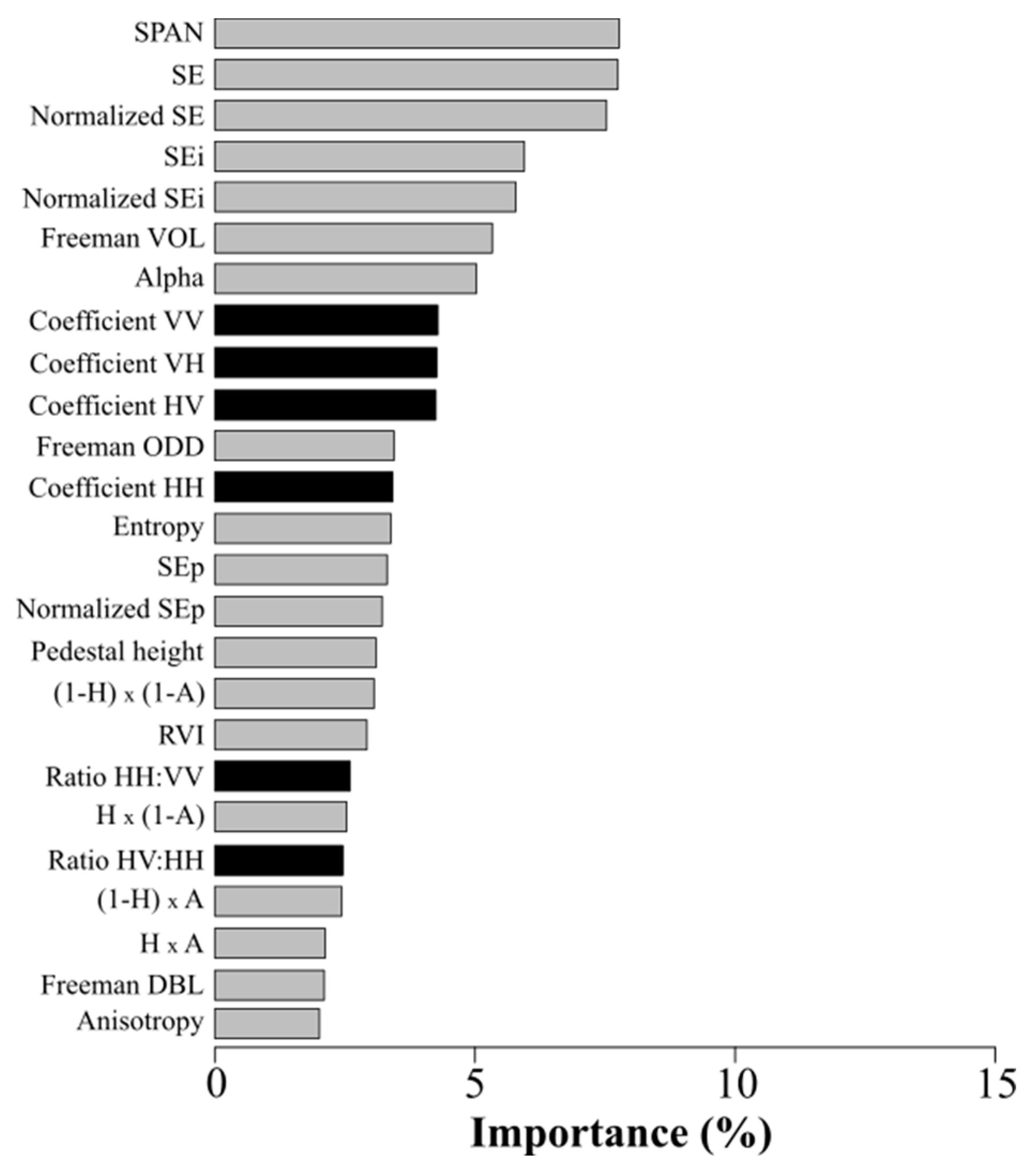
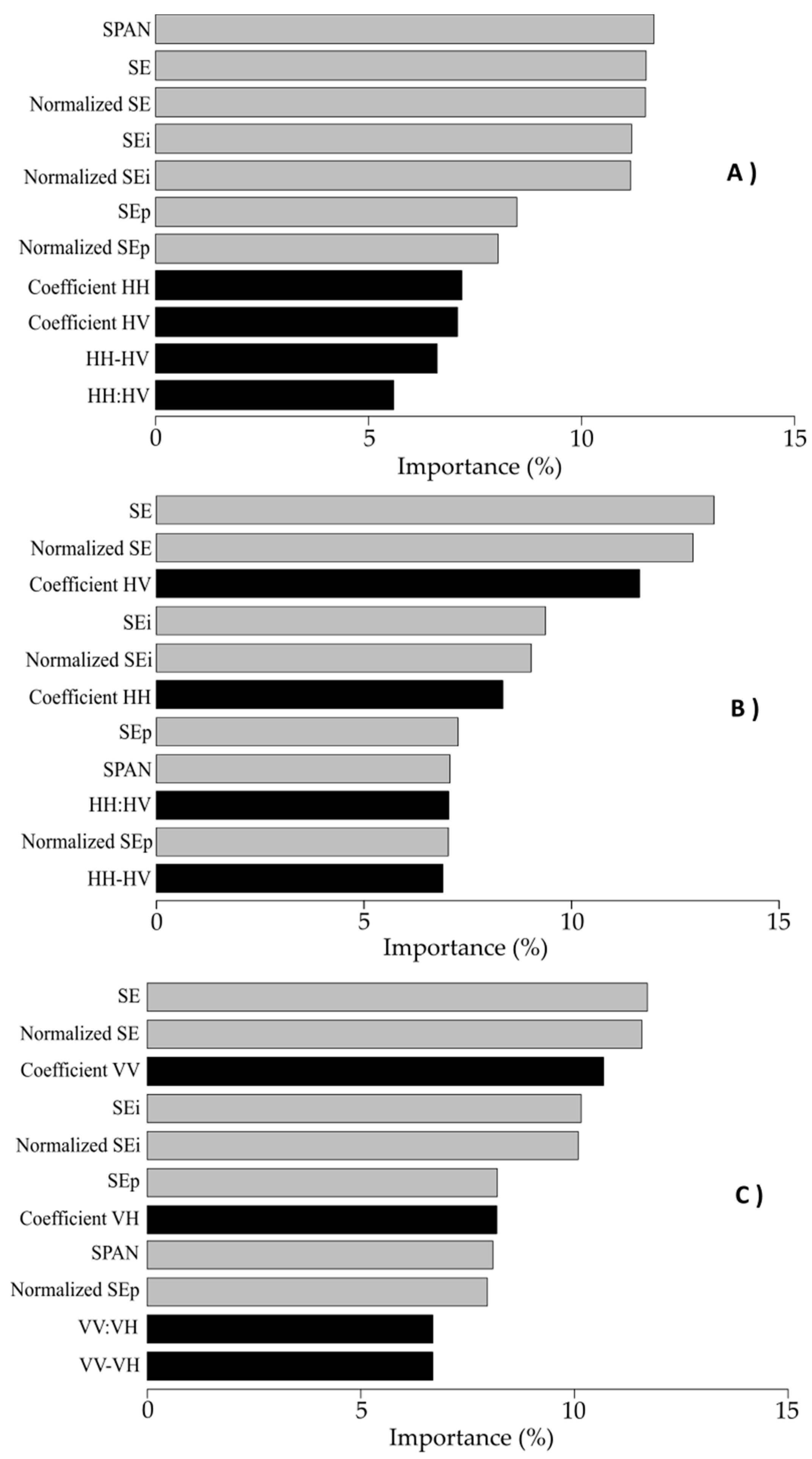
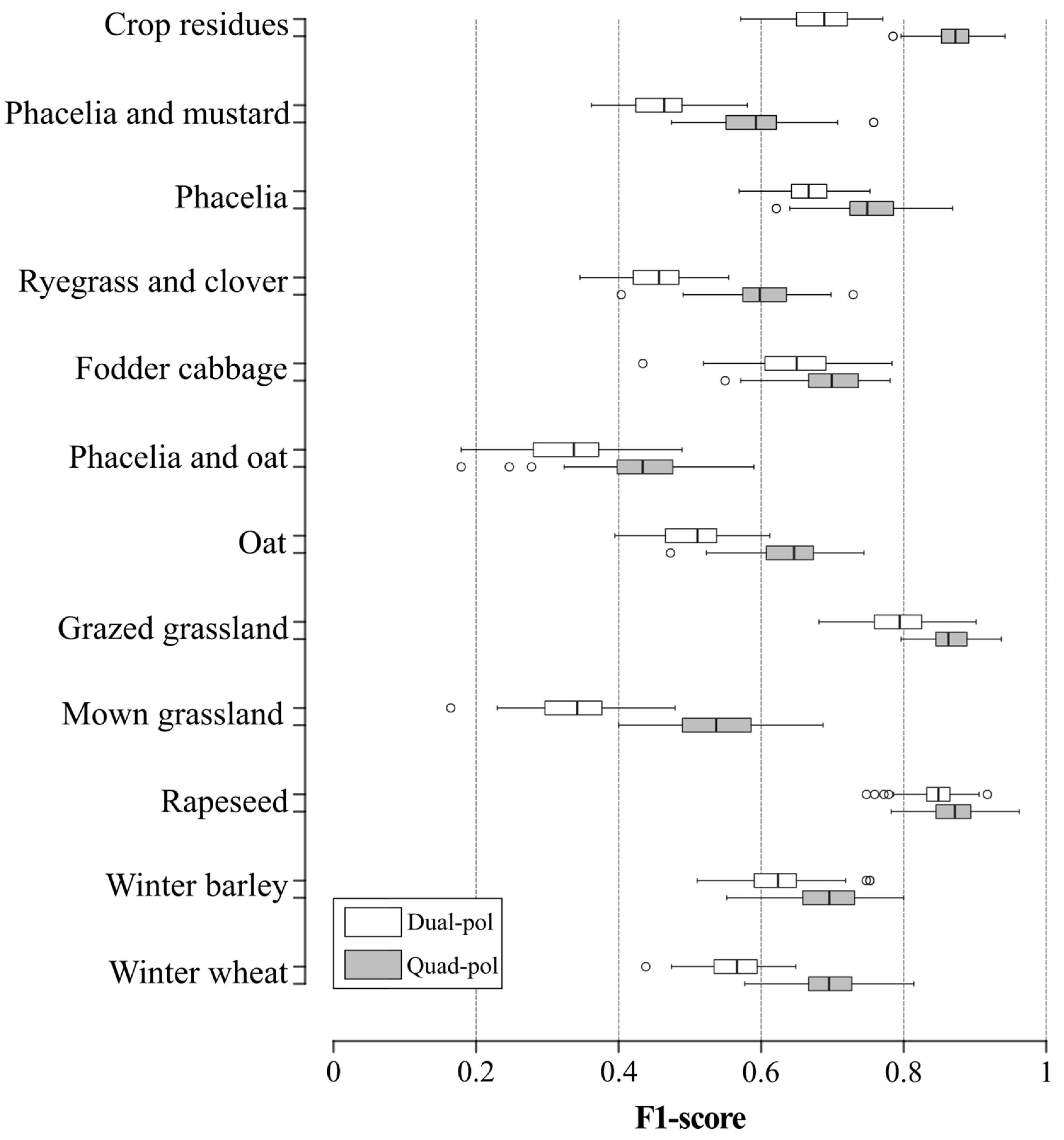
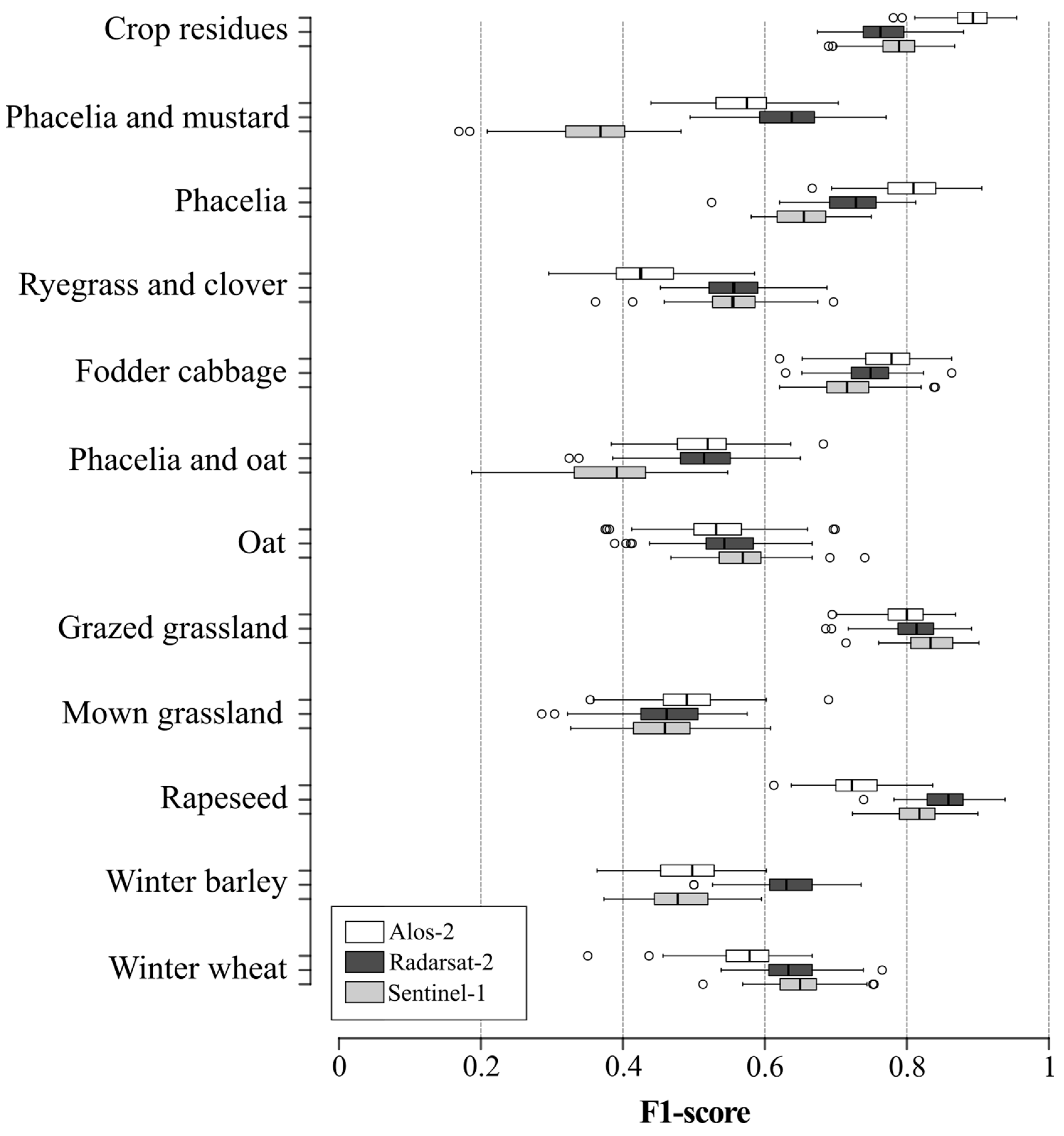
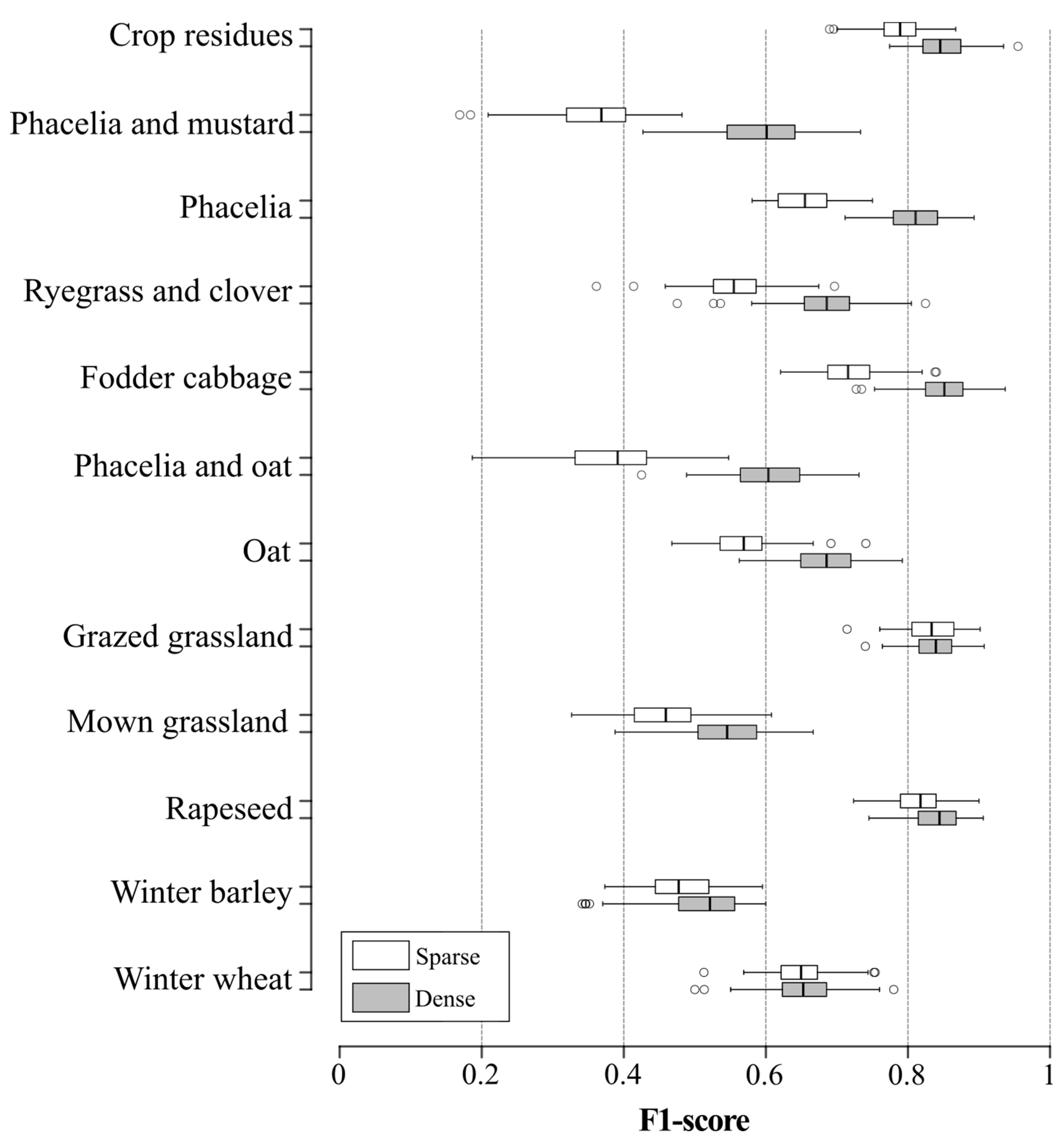
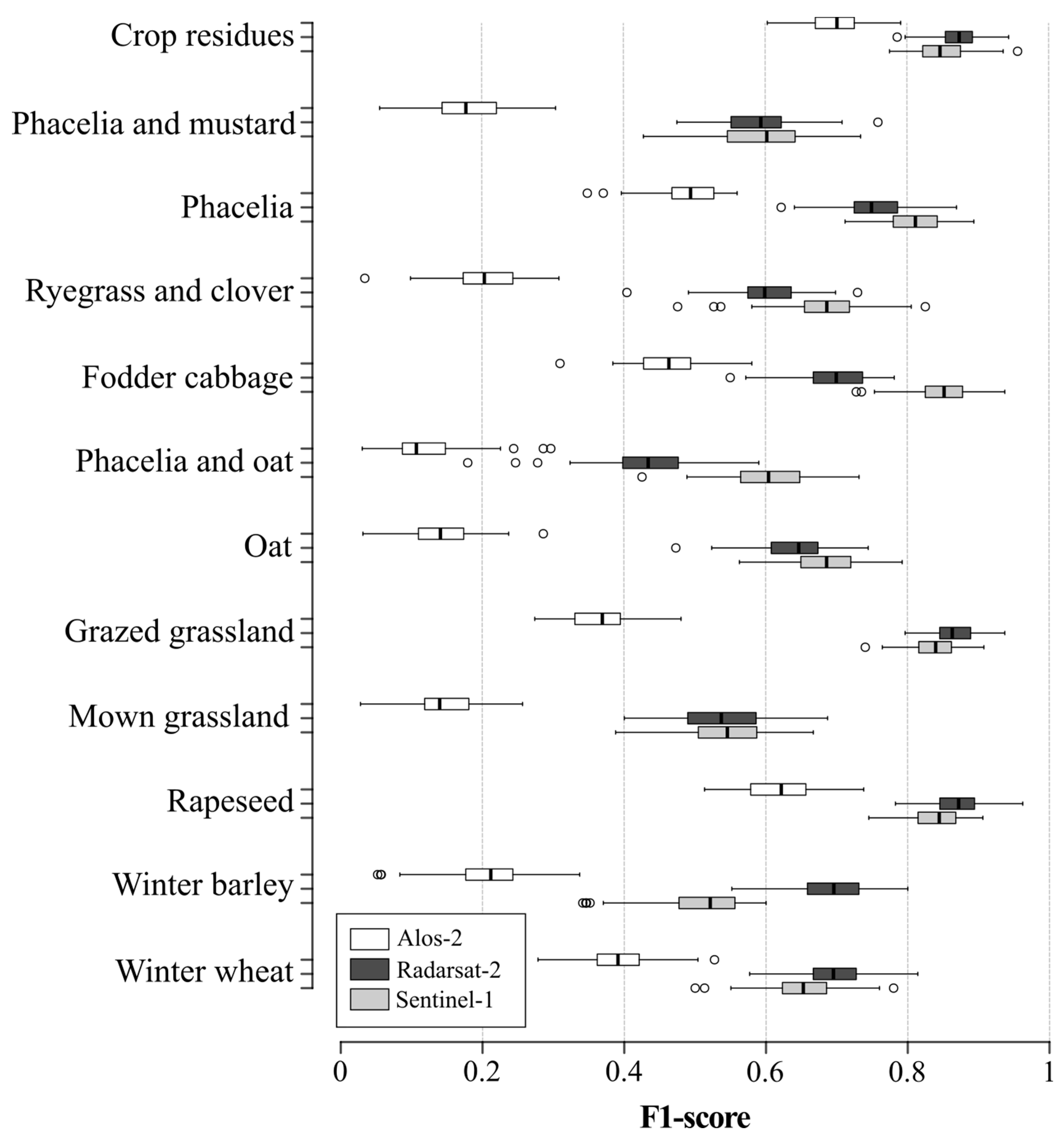
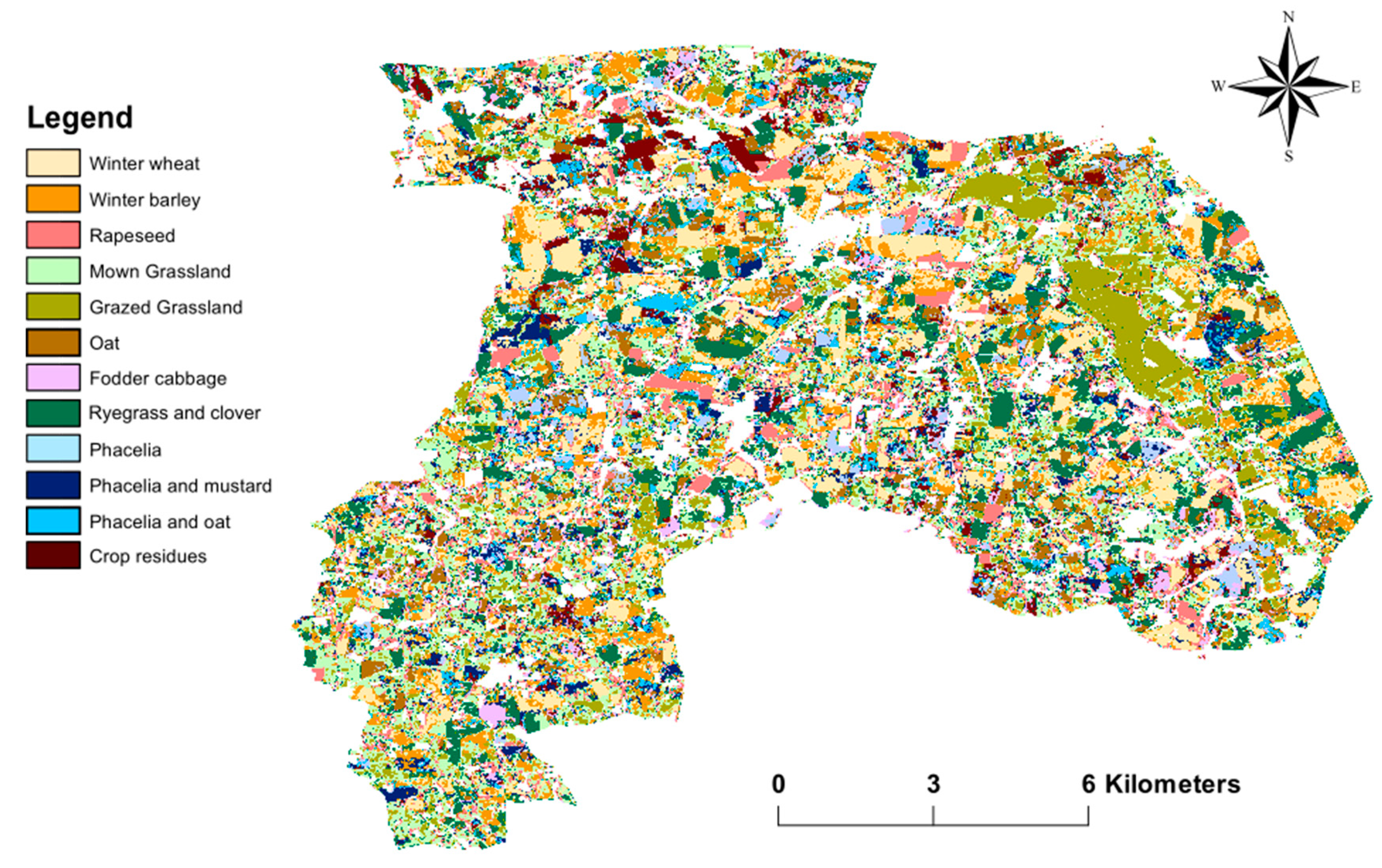
| Winter Land Use Type | Main Crops |
|---|---|
| Winter crops | Winter wheat |
| Winter barley | |
| Rapeseed | |
| Grasslands | Mown grasslands |
| Grazed grasslands | |
| Catch crops | Oat |
| Fodder cabbage | |
| Ryegrass and clover | |
| Phacelia | |
| Phacelia and mustard | |
| Phacelia and oat | |
| Crop residues | Maize stalks |
| RADARSAT-2 | Sentinel-1 | ALOS-2 | |
|---|---|---|---|
| Dates (M-D-Y) | 10-23-2016 11-16-2016 12-10-2016 01-03-2017 01-27-2017 02-20-2017 03-16-2017 04-09-2017 05-03-2017 05-27-2017 | 08-25-2016 09-18-2016* 09-30-2016* 10-12-2016* 10-24-2016* 11-05-2016* 11-17-2016* 11-29-2016* 12-11-2016* 12-23-2016* 01-04-2017* 01-16-2017* 01-28-2017* 02-09-2017* 02-21-2017* 03-05-2017* 03-17-2017* 03-29-2017* 04-10-2017* 04-22-2017* 05-04-2017* 05-16-2017 | 01-04-2017 02-04-2017 03-06-2017 04-15-2017 05-13-2017 06-10-2017 |
| Ground Resolution | 8.2 m | 2.3 m | 1.4 m |
| Azimuth Resolution | 4.7 m | 13.9 m | 1.9 m |
| Polarization | Quad (HH-VV-HV-VH) | Dual (VV – VH) | Dual (HH-HV) |
| Frequency | C-Band | C-Band | L-Band |
| Mode | Fine Quad Polarization (SLC) | Interferometric wide (SLC) | Spotlight (SLC) |
| Incidence Angle | 35° (right descending) | 31° to 46° (right descending) | 40° (left ascending) |
| Coverage | 18 km × 25 km | >250 km × 100 km | 25 km × 25 km |
| Land Use | 1 | 2 | 3 | 4 | 5 | 6 | 7 | 8 | 9 | 10 | 11 | 12 | Commission Error (%) |
|---|---|---|---|---|---|---|---|---|---|---|---|---|---|
| 1: Winter wheat | 32 | 1 | 4 | 1 | 0 | 0 | 2 | 0 | 1 | 0 | 2 | 0 | 74.4 |
| 2: Winter barley | 11 | 22 | 0 | 6 | 2 | 2 | 4 | 0 | 1 | 0 | 5 | 0 | 41.5 |
| 3: Rapeseed | 1 | 3 | 49 | 2 | 1 | 3 | 2 | 2 | 1 | 1 | 0 | 1 | 74.2 |
| 4: Mown grasslands | 0 | 3 | 2 | 28 | 7 | 0 | 1 | 0 | 0 | 2 | 1 | 2 | 60.9 |
| 5: Grazed grasslands | 0 | 0 | 0 | 0 | 44 | 0 | 1 | 2 | 1 | 0 | 0 | 0 | 91.7 |
| 6: Oat | 0 | 2 | 0 | 5 | 0 | 33 | 8 | 0 | 1 | 4 | 2 | 1 | 58.9 |
| 7: Phacelia and oat | 0 | 1 | 0 | 2 | 0 | 4 | 26 | 0 | 5 | 3 | 3 | 0 | 59.1 |
| 8: Fodder cabbage | 1 | 0 | 1 | 3 | 0 | 1 | 1 | 41 | 2 | 0 | 2 | 1 | 77.4 |
| 9: Ryegrass and clover | 1 | 1 | 1 | 1 | 2 | 2 | 0 | 4 | 36 | 0 | 1 | 0 | 73.5 |
| 10: Phacelia | 0 | 0 | 1 | 0 | 0 | 1 | 5 | 0 | 0 | 41 | 4 | 0 | 78.9 |
| 11: Phacelia and mustard | 1 | 0 | 0 | 0 | 0 | 1 | 0 | 0 | 0 | 0 | 34 | 1 | 91.9 |
| 12: Crop residues | 0 | 0 | 0 | 0 | 0 | 3 | 0 | 0 | 2 | 0 | 4 | 44 | 83.0 |
| Omission error (%) | 68.1 | 66.7 | 84.5 | 58.3 | 78.6 | 66.0 | 52.0 | 83.7 | 72.0 | 80.4 | 58.6 | 88.0 | 71.7 |
© 2019 by the authors. Licensee MDPI, Basel, Switzerland. This article is an open access article distributed under the terms and conditions of the Creative Commons Attribution (CC BY) license (http://creativecommons.org/licenses/by/4.0/).
Share and Cite
Denize, J.; Hubert-Moy, L.; Pottier, E. Polarimetric SAR Time-Series for Identification of Winter Land Use. Sensors 2019, 19, 5574. https://doi.org/10.3390/s19245574
Denize J, Hubert-Moy L, Pottier E. Polarimetric SAR Time-Series for Identification of Winter Land Use. Sensors. 2019; 19(24):5574. https://doi.org/10.3390/s19245574
Chicago/Turabian StyleDenize, Julien, Laurence Hubert-Moy, and Eric Pottier. 2019. "Polarimetric SAR Time-Series for Identification of Winter Land Use" Sensors 19, no. 24: 5574. https://doi.org/10.3390/s19245574
APA StyleDenize, J., Hubert-Moy, L., & Pottier, E. (2019). Polarimetric SAR Time-Series for Identification of Winter Land Use. Sensors, 19(24), 5574. https://doi.org/10.3390/s19245574




